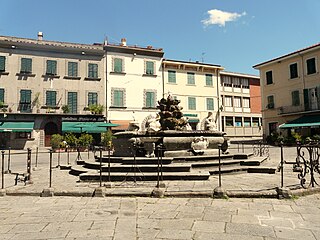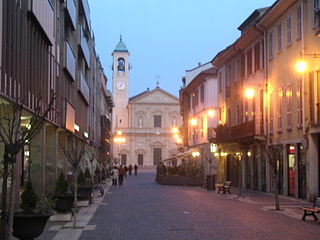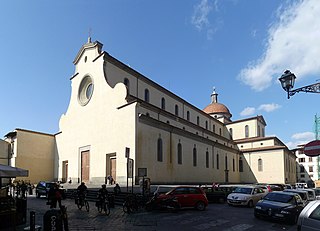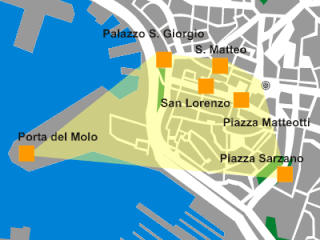
Arezzo is a city and comune in Italy and the capital of the province of the same name located in Tuscany. Arezzo is about 80 kilometres southeast of Florence at an elevation of 296 metres (971 ft) above sea level. In 2013 the population was about 99,000.

Santa Maria delle Grazie is a church and Dominican convent in Milan, northern Italy, and a UNESCO World Heritage Site. The church contains the mural of The Last Supper by Leonardo da Vinci, which is in the refectory of the convent.

Francesco del Cossa was an Italian Renaissance painter of the School of Ferrara.

Fivizzano is a comune in the province of Massa and Carrara, Tuscany, central Italy.

Vincenzo Foppa was an Italian painter from the Renaissance period. While few of his works survive, he was an esteemed and influential painter during his time and is considered the preeminent leader of the Early Lombard School. He spent his career working for the Sforza family, Dukes of Milan, in Pavia, as well as various other patrons throughout Lombardy and Liguria. He lived and worked in his native Brescia during his later years.

The Certosa di Pavia is a monastery and complex in Lombardy, northern Italy, situated near a small town of the same name in the Province of Pavia, 8 km north of Pavia. Built in 1396–1495, it was once located on the border of a large hunting park belonging to the Visconti family of Milan, of which today only scattered parts remain. It is one of the largest monasteries in Italy.

Saronno is a comune of Lombardy, Italy, in the province of Varese. It received the honorary title of city with a presidential decree in 1960. With an estimated population of 39,419 inhabitants, it is the most densely populated among the big municipalities in its province.

The National Roman Museum is a museum, with several branches in separate buildings throughout the city of Rome, Italy. It shows exhibits from the pre- and early history of Rome, with a focus on archaeological findings from the period of Ancient Rome.

The Palazzo Ducale di Mantova is a group of buildings in Mantua, Lombardy, northern Italy, built between the 14th and the 17th century mainly by the noble family of Gonzaga as their royal residence in the capital of their Duchy. The buildings are connected by corridors and galleries and are enriched by inner courts and wide gardens. The complex includes some 500 rooms and occupies an area of c. 34,000 m², which make it the sixth largest palace in Europe after the palaces of the Vatican, the Louvre Palace, the Palace of Versailles, the Royal Palace of Caserta and the Castle of Fontainebleau. It has more than 500 rooms and contains 7 gardens and 8 courtyards. Although most famous for Mantegna's frescos in the Camera degli Sposi, they have many other very significant architectural and painted elements.

The Basilica di Santo Spirito is a church in Florence, Italy. Usually referred to simply as Santo Spirito, it is located in the Oltrarno quarter, facing the square with the same name. The interior of the building – internal length 97 meters – is one of the preeminent examples of Renaissance architecture.

Angera is a town and comune located in the province of Varese, in the Lombardy region of northern Italy. In Roman times, it was an important lake port and road station. Formerly known as Anghiera, Angera received the title of city from Duke Ludovico il Moro in 1497. The town is situated on the eastern shore of Lago Maggiore.

San Giovanni a Carbonara is a Gothic church in Naples, Southern Italy. It is located at the northern end of via Carbonara, just outside what used to be the eastern wall of the old city. The name carbonara was given to this site allocated for the collection and burning of refuse outside the city walls in the Middle Ages.

The Cathedral of St. Anastasia is the Roman Catholic cathedral of Zadar, Croatia, seat of the Archdiocese of Zadar, and the largest church in all of Dalmatia.

The Duomo of Monza often known in English as Monza Cathedral is the main religious building of Monza, in northern Italy. Unlike most duomos it is not in fact a cathedral, as Monza has always been part of the Diocese of Milan, but is in the charge of an archpriest who has the right to certain episcopal vestments including the mitre and the ring. The church is also known as the Basilica of San Giovanni Battista from its dedication to John the Baptist.

Sant'Angelo is a church in Milan, Lombardy, northern Italy, belonging to the Franciscan Order.

San Marco is a church in Milan, northern Italy.

Zanetto Bugatto, also known as Zanetto Bugatti, was one of the most well documented court portraitists of the 1400s. A key painter of the Lombardy region, Bugatto worked for 15 years for the first two Sforza Dukes of Milan, particularly Duke Galeazzo Maria Sforza and his Duchess Bona of Savoy. His work was influenced by artists such as Rogier van der Weyden, Andrea Mantegna, and Jean Fouquet, all of whom he met during his travels. Bugatto's work was described by Galeazzo's ambassador Leonardo Botta as being similar to Sicilian painter Antonello da Messina. It is not clear whether Bugatto painted works other than portraits which he typically made on panel and in fresco. He is notable for being one of the first Italian artists, along with Antonello da Messina, to focus on portraiture in the Netherlandish style to such an exclusive extent.

The Abbey of Santa Maria di Rovegnano is a Cistercian monastic complex in the comune of Milan, Lombardy, northern Italy. The borgo that has developed round the abbey was once an independent commune called Chiaravalle Milanese, now included in Milan and referred to as the Chiaravalle district.

The Portinari Chapel is a Renaissance chapel at the Basilica of Sant'Eustorgio, Milan, northern Italy. Commenced in 1460 and completed in 1468, it was commissioned by Pigello Portinari as a private sepulchre and to house a silver shrine given by Archbishop Giovanni Visconti in 1340 containing the relic head of St. Peter of Verona, to whom the chapel is consecrated. The architect is unknown, the traditional attribution to Michelozzo having been succeeded with equal uncertainty by attributions to either Filarete or Guiniforte Solari, architect of the apses of the Certosa di Pavia and the church of San Pietro in Gessate in Milan.

Molo is a neighbourhood in the old town of the Italian city of Genoa. It was one of the six sestieri of ancient Genoa. At present is part of the Genoa's city Municipio I.





















